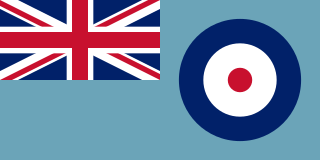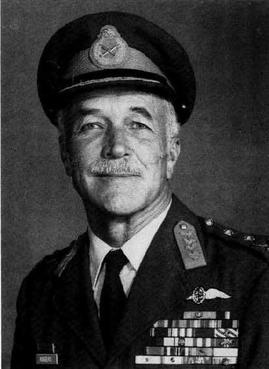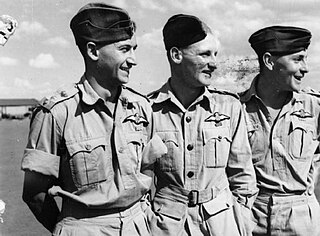Related Research Articles

The Desert Air Force (DAF), also known chronologically as Air Headquarters Western Desert, Air Headquarters Libya, the Western Desert Air Force, and the First Tactical Air Force (1TAF), was an Allied tactical air force created from No. 204 Group RAF under RAF Middle East Command in North Africa in 1941 to provide close air support to the British Eighth Army against Axis forces. Throughout the Second World War, the DAF was made up of squadrons from the Royal Air Force (RAF), the South African Air Force (SAAF), the Royal Australian Air Force (RAAF), the United States Army Air Forces (USAAF) and other Allied air forces.

2 Squadron is a squadron in the South African Air Force which was formed in 1940. The squadron has a long history, having been involved in every single combat action in which the SAAF has taken part. During the Second World War it made a name for itself in the battles for East Africa, before distinguishing itself in North Africa as part of the Desert Air Force, and later in Italy.

1 Squadron SAAF was an air force squadron of the South African Air Force and was formed at Air Force Station Swartkop in February 1920, equipped with De Havilland DH.9s part of the Imperial Gift donation to South Africa by Britain. On 31 August 1939 the squadron was re-designated as 1 Bomber/Fighter Squadron and this was then changed to 11 (Bomber) Squadron in December 1939. The squadron was resurrected in February 1940 by the renumbering of 6 Squadron, equipped with four Hurricane Mk 1s and six Furies.

Wing Commander Lance Cleo "Wildcat" Wade DSO, DFC & Two Bars was an American pilot who joined the Royal Air Force (RAF) during the Second World War and became a flying ace. He remained with RAF until his death in a flying accident in 1944 in Italy. He was described as a "distinguished American fighter ace who epitomized perhaps more than any other American airman the wartime accords between Britain and the United States".

Robert Harry Doherty Rogers was a Chief of the South African Air Force. He joined the South African Air Force (SAAF) in 1940, and served in the Second World War and the Korean War. He subsequently rose through the ranks to become Chief of the SAAF. After his military career he entered politics and served as a Member of Parliament.

Robert Henry Maxwell Gibbes, was an Australian fighter ace of World War II, and the longest-serving wartime commanding officer of No. 3 Squadron RAAF. He was officially credited with 10¼ aerial victories, although his score is often reported as 12, including two shared; Gibbes was also credited with five aircraft probably destroyed, and a further 16 damaged. He commanded No. 3 Squadron in North Africa from February 1942 to April 1943, apart from a brief period when he was wounded.

John Everitt Frost, was a South African fighter ace during the Second World War. He was the highest-scoring member of a South African Air Force squadron during the war, credited with the destruction of 15 Axis aircraft. South African pilots with higher numbers of kills, such as Pat Pattle and Adolph "Sailor" Malan, were members of the British Royal Air Force.
Maurice Michael Stephens, was a Royal Air Force flying ace of the Second World War. Stephens scored 17 kills, three shared kills, one probable kills and five damaged.
Air Vice Marshal Sir Matthew Brown Frew, was a Scottish First World War flying ace, credited with 23 aerial victories, who went on to serve as a senior officer in the Royal Air Force and South African Air Force during the Second World War.

Peter Jeffrey, was a senior officer and fighter ace in the Royal Australian Air Force (RAAF). Born in Tenterfield, New South Wales, he joined the RAAF active reserve in 1934, and transferred to the Permanent Air Force (PAF) shortly before World War II. Posted to the Middle East in July 1940, Jeffrey saw action with No. 3 Squadron and took command of the unit the following year, earning the Distinguished Flying Cross for his energy and fighting skills. He was appointed wing leader of No. 234 Wing RAF in November 1941, and became an ace the same month with his fifth solo victory. The next month he was awarded the Distinguished Service Order for his achievements, which included rescuing a fellow pilot who had crash landed in the desert.

7 Squadron was a unit of the South African Air Force which served in the Second World War as well as in South Africa between 1951 and 1992. During the war, the squadron was used as a fighter squadron deployed to the Western Desert as well as in the Aegean, Italy and Ceylon. The squadron was inactive from the end of the war until 1951 when it re-activated as a citizen force training squadron, a role it retained during two periods of active service until 1992, when it was disbanded for the last time.
The History of the South African Air Force spans the First World War, Rand Rebellion of 1922, the Second World War, the Korean War, the South African Border War, and varied peacekeeping operations since 1994. Its battle honours include German South West Africa 1914–15, German East Africa 1915–1918, East Africa: 1939–1941, Middle East: 1941–43, Madagascar 1942, Italy 1943–1945, the Balkans 1943–1945, and Korea 1950–1953.

Alan Charles Rawlinson, was an Australian airman who became a fighter ace in World War II. He was credited with at least eight aerial victories, as well as two aircraft probably destroyed, and another eight damaged.
Andrew Bosman was a South African flying ace of World War II, credited with shooting down at least eight aircraft. He was killed in a postwar flying accident.
Peter Metelerkamp was a South African flying ace of World War II, credited with 5 'kills'.

Servaas van Breda Theron was a South African World War II fighter ace, credited with 10 'kills'.

Laurence 'Laurie' Wilmot was a South African flying ace of World War II, credited with 4 'kills'.

Gerald John Le Mesurier (1914-1943) was a South African flying ace of World War II, credited with 3 'kills'.

Douglas William Golding is a South African flying ace of World War II, credited with 3 'kills'.
Dennis Vernon Dold Lacey (1919-1942) was a South African flying ace of World War II, credited with 5 'kills' and 2 probables.
References
- 1 2 3 4 Shores, C; Williams C (15 July 2008). Aces High: A Tribute to the Most Notable Fighter Pilots. Grub Street. ISBN 978-1-898697-00-8.
- ↑ "No. 35334". The London Gazette . 4 November 1941. p. 6368.
- ↑ "No. 36015". The London Gazette . 14 May 1943. p. 2152.